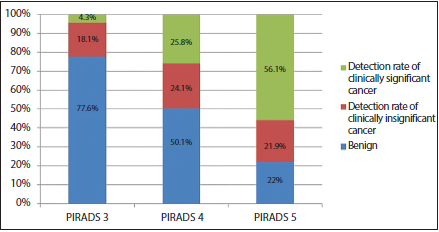Objective: This study aimed to evaluate the effect of prostate volume and lesion size on the clinically significant prostate cancer (csPCa) detection rates of transrectal ultrasonography (TRUS)-guided prostate biopsies, performed by a cognitive targeting method for sampling peripheral zone lesions.
Material and methods: We retrospectively enrolled 219 consecutive patients, who underwent multiparametric magnetic resonance imaging with a 3-T scanner and had peripheral zone lesions suspected for prostate cancer. All of these patients underwent combined cognitive targeted biopsy of suspicious lesions and TRUS-guided systematic biopsy. The detection rates of csPCa according to different lesion diameters (<5 mm, 5–9.9 mm, and ≥10 mm) and prostate volumes (<30 mL, 30–49.9 mL, 50–79.9 mL, and ≥80 mL) were calculated per lesion basis. In addition, subgroup analysis of csPCa detection rates was performed according to Prostate Imaging Reporting and Data System scores of lesions.
Results: The csPCa detection rates according to lesion diameters <5 mm, 5–9.9 mm, and ≥10 mm were 4%, 9.8%, and 33.1%, respectively, and were significantly lower for lesions <10 mm (p<0.001). The csPCa detection rates were 61.5%, 24.1%, 16.2%, and 6.9%, respectively, for prostate volumes <30 mL, 30–49.9 mL, 50–79.9 mL, and ≥80 mL, and were significantly higher for prostate volumes <30 mL (p<0.001).
Conclusions: Clinicians should be very careful when they prefer cognitive targeted prostatic biopsy in patients with periferal zone lesions less than 10 mm and with prostate volumes greater than 30 mL, because of significantly low csPCa detection rates.
Cite this article as: Özden E, Akpınar Ç, İbiş A, Kubilay E, Erden A, Yaman Ö. Effect of lesion diameter and prostate volume on prostate cancer detection rate of magnetic resonance imaging: Transrectal-ultrasonography-guided fusion biopsies using cognitive targeting. Turk J Urol 2021; 47(1): 22-9.

.png)
.jpg)
.png)
.png)
